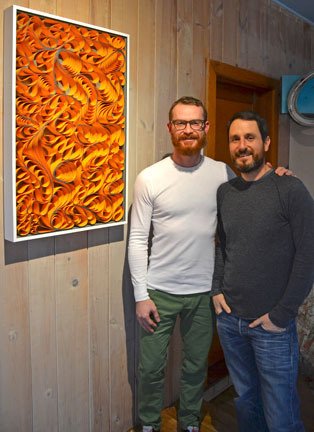The floors are covered in colored canvas of past pieces and everything is on wheels for easy mobility. Stallman Studio is a place to create and connect, a true working space.
This is the studio of Stephen Stum, 32, and Jason Hallman, 41, an artist duo and partners in life. As the studio’s name — a combination of Stum and Hallman — suggests, they work together in tandem to create each piece.
Previously based in Seattle, Stum and Hallman relocated to Langley and opened their studio at 101 First St., Langley in October 2013. They were captivated by the beauty of South Whidbey after regularly visiting friends, and when the opportunity came, they thought, “Why not Whidbey?” Stum said.
Together they created a new technique that combines painting and sculpture that has taken off and is now called “canvas on edge.” Their pieces are sold in Bellevue at Hall | Spassov Gallery and in a gallery in California. The pair has also found success in art festivals across the nation, most recently in Chicago and an upcoming event in New York. Their work is selling as fast as they can create it.
The technique involves cutting large sheets of canvas into strips, which are then hand-painted on the side and ends to stand on its edge in an open 3-D boxed frame. From there, the strips are molded into patterns based on biology and gradients in nature, “almost like a kaleidoscope,” Hallman said.
“There are no hard lines. It’s completely organic and never creases or breaks,” Stum said. “It’s hypnotic searching through the shapes.”
The end result is a maze of curves and color, changing with each step the viewer takes. The light catches each curve in a different way, showing different sides and shadows throughout the day.
Each piece takes about a month to create. The smaller ones, measuring 2 feet by 3 feet, begin at about $4,000. The larger and more typical size is 4 feet by 6.5 feet, which fetch prices up to $18,000, depending on the complexity of the piece.
The work is a fusion of both their backgrounds and their exploratory nature. Stum hails from a graphic and industrial design background while Hallman worked in furniture design and is an artist as well.
Now, both are full-time artists and have worked on this technique for a year and a half. For a long time, Stum said he didn’t even think of it as work and more as exploration and creation.
“The work would not be born without us together,” Hallman said.
They work fluidly, one picking up where the other left off, each able to do the same work and critiquing each other.
“Expressing new ideas is key,” Stum said. “It’s still playing and the dialogue is definitely a roller coaster.”
Stum and Hallman are available at the studio by appointment or “by chance,” as stated on the door, during the weekday. One of the things they enjoy most about the area is the monthly art walk.
“It’s great because we can really let the work shine. And we can share, in a way, because we’re not a gallery,” Stum said.


